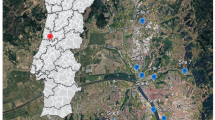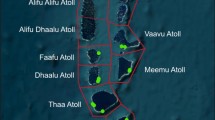Abstract
Mangrove forests are one of the most sensitive forest habitats in Iran due to the presence of endangered and rare species. This study aimed to survey the relationship among ecological parameters of these forests in 4 habitats in southern Iran with the geographical distribution of genetic types, study the diversity of these types, and develop maps of their habitat suitability. After DNA extraction experiments, molecular variance analysis, and the estimation of genetic parameters, 4 genetic types were identified. The relationship of these genetic types with the environmental variables was modeled in MaxEnt software. The habitat suitability map of A. marina genetic types was developed, along with response models to ecological parameters. The results showed that among the studied populations, Qeshm has the highest, and Assaluyeh has the lowest genetic diversity. Furthermore, Qeshm population was only population with specific alleles. The study of the relationship between the establishment of genetic types and environmental parameters in general showed a high impact of salinity and soil temperature, NDVI, wave height, and evaporation in study regions. The red type is native to all habitats in southern Iran, and the purple type is ecologically inferior. The high accuracy of habitat suitability modeling for different types (68 to 99%) shows the efficiency of used model. The results of this research showed that environmental parameters affect the geographical distribution of A. marina genotypes.









Similar content being viewed by others
Data availability
The datasets used and/or analyzed during this study are available from the corresponding author. The datasets supporting the conclusions of this article are included within the article.
References
Afefe A, Abbas SMA, Khedr AH, Hatab EB (2019) Physical and chemical characteristics of mangrove soil under marine influence. A case study on the Mangrove Forests at Egyptian-African Red Sea Coast. Egypt J Aquat Biol Fisheries 23(3):385–399. https://doi.org/10.21608/EJABF.2019.47451
Alsumaiti T, Shahid S (2018) A Comprehensive analysis of mangrove soil in eastern lagoon National Park of Abu Dhabi Emirate. Int J Bus Appl Soc Sci (IJBASS) 4(5): 39–56. https://nbnresolving.org/urn:nbn:de:0168-ssoar-57449-3
Arnaud-Haond S, Teixeira S, Massa SI, Billot C, Saenger P, Coupland G, Duarte CM, Serrao EA (2006) Genetic structure at range edge: low diversity and high inbreeding in southeast Asian mangrove (Avicennia marina) populations. Mol Ecol 15(12):3515–3525. https://doi.org/10.1111/j.1365-294X.2006.02997.x
Cao B, Bai C, Zhang L, Li G, Mao M (2016) Modeling habitat distribution of Cornus officinalis with Maxent modeling and fuzzy logics in China. J Plant Ecol 9(6):742–751. https://doi.org/10.1093/jpe/rtw009
Chakraborty A, Joshi PK, Sachdeva K (2016) Predicting distribution of major forest tree species to potential impacts of climate change in the central Himalayan region. Ecol Eng 97:593–609. https://doi.org/10.1016/j.ecoleng.2016.10.006
Chang H, Han SH, Kim S, An J, Alatalo J, Son Y (2020) Interactions between topsoil properties and ecophysiological responses of mangroves (Avicennia marina) along the tidal gradient in an arid region in Qatar. Turk J Agric for 44(2):121–126. https://doi.org/10.3906/tar-1905-17
Charrua AB, Bandeira SO, Catarino S, Cabral P, Romeiras MM (2020) Assessment of the vulnerability of coastal mangrove ecosystems in Mozambique. Ocean Coast Manag. https://doi.org/10.1016/j.ocecoaman.2020.105145
Doyle JJ (1992) Gene trees and species trees: molecular systematics as one-character taxonomy. Syst Bot 7(1):144–163
Ghanavati I, Zolgharnein H, Ghasemi M, Khaledi H (2015) Study of genetic diversity of hara trees on the coast of Hormozgan Province using rapid molecular method. J Mar Sci Technol 13(4):81–90. https://doi.org/10.22113/JMST.2015.7990. (In Persian)
Ghanbari Motlagh M, Abbasnezhad Alchin A, Daghestani M (2022) Detection of high fire risk areas in Zagros Oak forests using geospatial methods with GIS techniques. Arab J Geosci 15:835. https://doi.org/10.1007/s12517-022-10096-4
Gharacheh M, Salari Aliabadi M, Ghaemmaghami S, Qasemi A (2020) Genetic diversity of plantations and natural stands of Avicenna marina across northern coast of Persian Gulf. PEC 8(16): 217–228. (In Persian). http://pec.gonbad.ac.ir/article-1-576-fa.html
Ghayoumi R, Ebrahimi E (2020) Predicting the potential distribution of Avicennia marina across mangrove forest area in southern Iran using Biochemical datase. JOC 10 (40): 55–63. (In Persian). http://joc.inio.ac.ir/article-1-1530-fa.html
Ghayoumi R, Ebrahimi E, Hosseini Taifeh F, Keshtkar M (2020) Predicting the effects of climate change on the distribution of mangrove forests in Iran using the maximum entropy model. Remote sensing and GIS in natural resources (Application of remote sensing and GIS in natural resources sciences) 10(2): 34–47. (In Persian). https://girs.bushehr.iau.ir/article_666805.html
Hegazy AK, Ali AA, Khadr FG, Azab EM (2002) Site–dependent variation in populations of Avicennia marina (Forssk.). Vierh in southern Sinai Egypt. Aquat Bot 53:32–45. https://doi.org/10.22059/jfwp.2017.61609
Hu W, Wang Y, Dong P, Zhang D, Yu W, Ma Z, Chen G, Liu Z, Du J, Chen B, Lei G (2020) Predicting potential mangrove distributions at the global northern distribution margin using an ecological niche model: determining conservation and reforestation involvement. For Ecol Manag. https://doi.org/10.1016/j.foreco.2020.118517
Ihwan I, Hakim L (2019) Genetic diversity of Rhizophora mucronata in eastern region of Timor Island, Indonesia as revealed by RAPD. Biodivers J Biol Divers 20(11):3364–3371. https://doi.org/10.13057/biodiv/d201133
Jafarnia Sh, Hojjati M, Koch Y (2013) The effect of soil and water characteristics on vegetative characteristics of mangrove trees in Qeshm habitat of Hormozgan province. Environ Sci 9 (4): 133–148. (In Persian). https://envs.sbu.ac.ir/article_96416.html
John E, Bunting P, Hardy A, Roberts O, Giliba R, Silayo DS (2020) Modelling the impact of climate change on Tanzanian forests. Divers Distrib 26(12):1663–1686. https://doi.org/10.1111/ddi.13152
Kharazmi R, Tavili A, Rahdari MR, Chaban L, Panidi E, Rodrigo-Comino J (2018) Monitoring and assessment of seasonal land cover changes using remote sensing: a 30-year (1987–2016) case study of Hamoun Wetland. Iran Environ Monitor Assess 190(6):1–23. https://doi.org/10.1007/s10661-018-6726-z
Le HG, Hong PN, Tuan MS, Harada K (2003) Genetic variation of Avicennia marina (Forsk.) Vierh. (Avicenniaceae) in Vietnam revealed by microsatellite and AFLP markers. Genes Genet Syst 78(6):399–407. https://doi.org/10.1266/ggs.78.399
Lestari NS, Elith J (2019) Modelling the distribution of Shorea leprosula in Kalimantan, Indonesia: a tool for conservation planning. In: IOP conference series: earth and environmental science 285(1): p 012010.https://doi.org/10.1088/1755-1315/285/1/012010
Liu ZJ, Cordes JF (2004) DNA marker technologies and their applications in aquaculture genetics. Aquaculture 238(1–4):1–37
Maguire TL, Collins GG, Sedgley M (1994) A modified CTAB DNA extraction procedure for plants belonging to the family Proteaceae. Plant Mol Biol Report 12(2):106–109. https://doi.org/10.1007/BF02668371
Maguire TL, Edwards KJ, Saenger P, Henry R (2000) Characterisation and analysis of microsatellite loci in a mangrove species, Avicennia marina (Forsk.) Vierh. (Avicenniaceae). Theor Appl Genet 101(1):279–285. https://doi.org/10.1007/s001220051480
Malekian M, Sadeghi M (2020) Predicting impacts of climate change on the potential distribution of two interacting species in the forests of western Iran. Meteorol Appl. https://doi.org/10.1002/met.1800
Manurung J, Siregar IZ, Kusmana C, Dwiyanti FG (2017) Genetic variation of the mangrove species Avicennia marina in heavy metal polluted estuaries of Cilegon industrial area Indonesia. Biodivers J Biol Divers 18(3):1109–1115. https://doi.org/10.13057/biodiv/d180331
Naghipour AA, Asl ST, Ashrafzadeh MR, Haidarian M (2021) Predicting the potential distribution of Crataegus azarolus L. under climate change in central Zagros Iran. J Wildlife Biodivers 5(4):28–43. https://doi.org/10.22120/jwb.2021.530532.1229
Namiranian M (2010) Measurement of tree and forest biometry. University of Tehran press, Tehran
Nei M, Li WH (1979) Mathematical model for studying genetic variation in terms of restriction endonucleases. Proc Nat Acad Sci USA 76:5269–5273. https://doi.org/10.1073/pnas.76.10.5269
Nguyen HT, Stanton DE, Schmitz N, Farquhar GD, Ball MC (2015) Growth responses of the mangrove Avicennia marina to salinity: development and function of shoot hydraulic systems require saline conditions. Ann Bot 115(3):397–407. https://doi.org/10.1093/aob/mcu257
Numbere AO, Camilo GR (2017) Effect of temperature and precipitation on global mangrove Rhizophora species distribution. Am J Environ Sci 13(5):342–350. https://doi.org/10.3844/ajessp.2017.342.350
Peakall ROD, Smouse PE (2006) GENALEX 6: GenAlEx 6.5: genetic analysis in Excel. Population genetic software for teaching and research—an update molecular ecology notes. Bioinformatics 28(19):2537–2539. https://doi.org/10.1093/bioinformatics/bts460
Petrosian H, Danehkar A (2013) Identifying effective criteria in the spatial distribution of mangrove forests (case study: mangrove forests). J Environ Sci Eng 53–54:81-90 (In Persian). https://www.magiran.com/paper/1225830
Petrosian H, Kar AD, Ashrafi S, Feghhi J (2016) Investigating environmental factors for locating mangrove ex-situ conservation zones using GIS spatial techniques and the logistic regression algorithm in mangrove forests in Iran. Pol J Environ Stud 25(5):2097–2106. https://doi.org/10.15244/pjoes/62640
Phillips SJ, Dudík M (2008) Modeling of species distributions with Maxent: new extensions and a comprehensive evaluation. Ecography 31(2):161–175. https://doi.org/10.1111/j.2007.0906-7590.05203.x
Phillips SJ, Anderson RP, Schapire RE (2006) Maximum entropy modeling of species geographic distributions. Ecol Model 190(3–4):231–259. https://doi.org/10.1016/j.ecolmodel.2005.03.026
Phillips SJ, Dudík M, Schapire RE (2004) A maximum entropy approach to species distribution modeling. In: Proceedings of the twenty-first international conference on machine learning, 655–662
Qin A, Liu B, Guo Q, Bussmann RW, Ma F, Jian Z, Xu G, Pei S (2017) Maxent modeling for predicting impacts of climate change on the potential distribution of Thuja sutchuenensis Franch., an extremely endangered conifer from southwestern China. Glob Ecol Conserv 10:139–146. https://doi.org/10.1016/j.gecco.2017.02.004
Rodríguez-Medina K, Yañez-Arenas C, Peterson AT, Euán Ávila J, Herrera-Silveira J (2020) Evaluating the capacity of species distribution modeling to predict the geographic distribution of the mangrove community in Mexico. PLoS ONE. https://doi.org/10.1111/j.2007.0906-7590.05203.x
Sadat Fatemi Azarkhavarani S, Rahimi M, Tarkesh M, Ravanbakh H (2017) Prediction of Juniperus excelsa M. Bieb. geographical distribution using by climate data under the conditions of current and future in Semnan Province. Iran J For 9(2): 233–248. (In Persian). http://www.ijf-isaforestry.ir/article_49979.html
Saifullah SM, Gul S, Rasool F (2004) Anomalous aerial roots in grey mangroves of an arid climate lagoon. Pak J Bot 36(2):463–466
Smith A, Page B, Duffy K, Slotow R (2012) Using Maximum Entropy modeling to predict the potential distributions of large trees for conservation planning. Ecosphere 3(6):1–21. https://doi.org/10.1890/ES12-00053.1
Tesfamariam BG, Gessesse B, Melgani F (2022) MaxEnt-based modeling of suitable habitat for rehabilitation of Podocarpus forest at landscape-scale. Environ Sys Res 11(1):1–12. https://doi.org/10.1186/s40068-022-00248-6
Triest L, Del Socorro A, Gado VJ, Mazo AM, Sierens T (2021) Avicennia genetic diversity and fine-scaled structure influenced by coastal proximity of mangrove fragments. Front Mar Sci. https://doi.org/10.3389/fmars.2021.643982
Valipour Kahrood HV, Korori SAA, Pirseyedi M, Shirvany A, Danehkar A (2008) Genetic variation of mangrove species Avicennia marina in Iran revealed by microsatellite markers. Afr J Biotechnol 7(17): 3017–3021. http://www.academicjournals.org/AJB
Vessella F, Schirone B (2013) Predicting potential distribution of Quercus suber in Italy based on ecological niche models: conservation insights and reforestation involvements. For Ecol Manage 304:150–161. https://doi.org/10.1016/j.foreco.2013.05.006
Wang Y, Dong P, Hu W, Chen G, Zhang D, Chen B, Lei G (2022) Modeling the climate suitability of northernmost mangroves in china under climate change scenarios. Forests. https://doi.org/10.3390/f13010064
Zolgharnein H, Kamyab M, Keyvanshokooh S, Ghasemi A, Nabavi SMB (2010) Genetic diversity of Avicennia marina (Forsk.) Vierh. populations in the Persian Gulf by microsatellite markers. J Fish Aquat Sci 5(4):223–229. https://doi.org/10.3923/jfas.2010.223.229
Acknowledgements
The authors wish to thank all who assisted in this work.
Author information
Authors and Affiliations
Corresponding author
Ethics declarations
Conflict of interest
There is no conflict of interest.
Ethical approval
This article does not contain any studies with human participants performed by any of the authors.
Additional information
Editorial responsibility: M. Abbaspour.
Rights and permissions
Springer Nature or its licensor (e.g. a society or other partner) holds exclusive rights to this article under a publishing agreement with the author(s) or other rightsholder(s); author self-archiving of the accepted manuscript version of this article is solely governed by the terms of such publishing agreement and applicable law.
About this article
Cite this article
Koochaki Chenani, S., Babaie Kafaky, S., Kiadaliri, H. et al. Relationship among environmental factors with distribution of genetic types of Avicennia marina in mangrove ecosystems of Iran. Int. J. Environ. Sci. Technol. 20, 2713–2732 (2023). https://doi.org/10.1007/s13762-023-04814-y
Received:
Revised:
Accepted:
Published:
Issue Date:
DOI: https://doi.org/10.1007/s13762-023-04814-y




